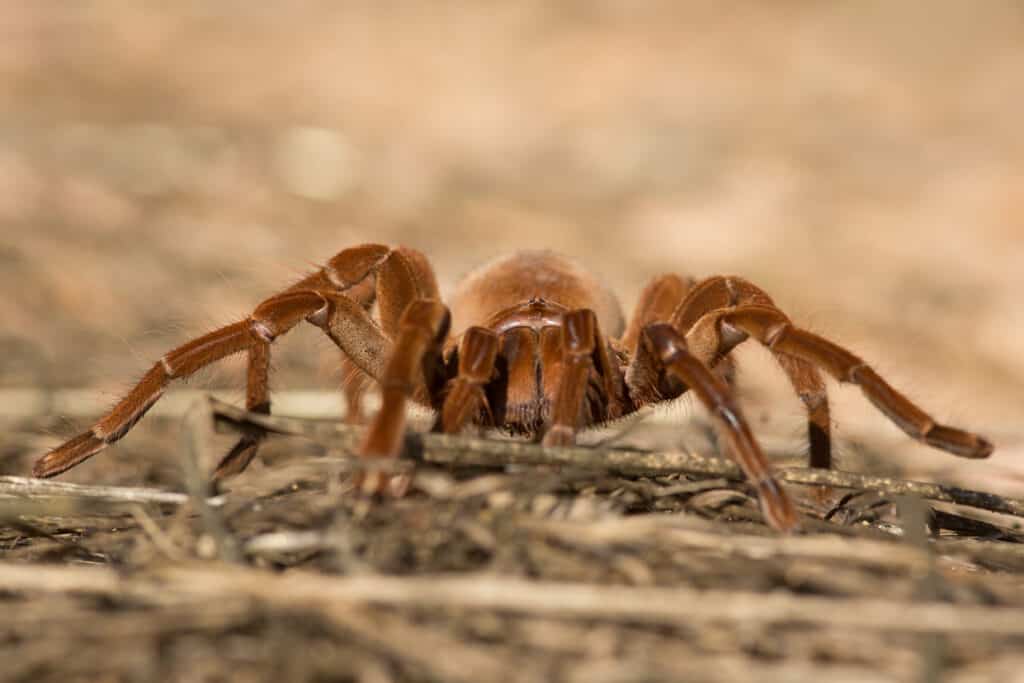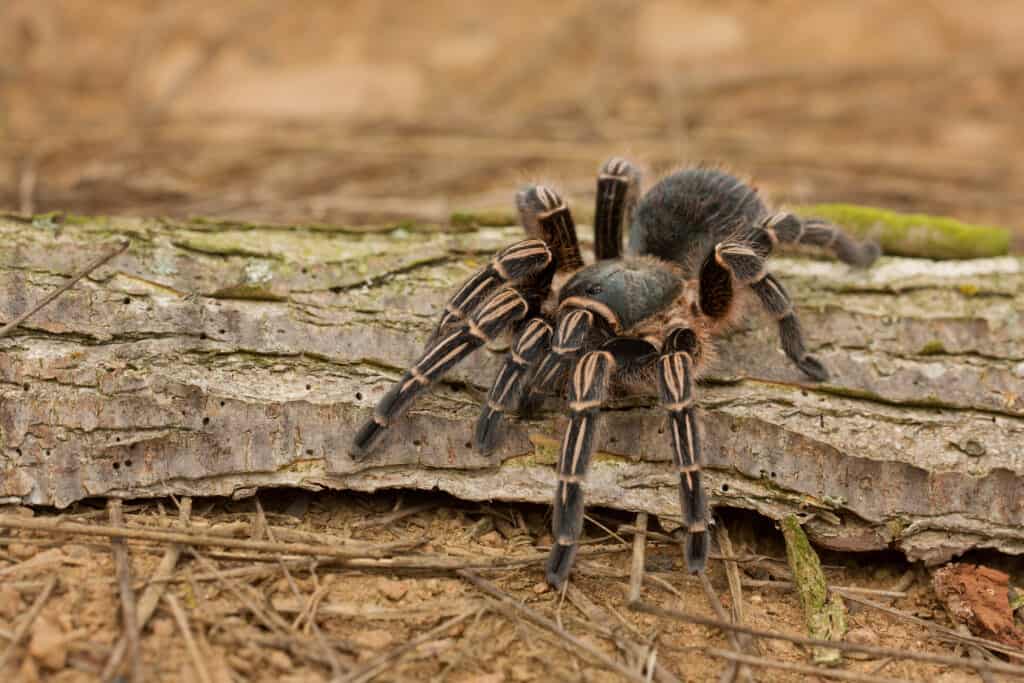Migration is the seasonal movement of animals. At a particular time of the year, animals swap habitats for various reasons. Many species migrate to get food, Others for better habitat for their young or to avoid extreme weather conditions. Birds do it, fishes do it, whales do it, and you’ve probably heard about tarantula migration. What exactly does tarantula migration entail, and how is it different from migration for other animal species? Read on to find out.
Reasons for Tarantula Migration

Tarantulas move out in search of a mate.
©Milan Zygmunt/Shutterstock.com
Tarantula migration isn’t migration in the strictest sense of the term. It is more of emergence than actual migration. These spiders usually stick to their burrows and rarely wander around.
Unlike migration in other animals, tarantulas only come out in large numbers in search of a mate. Because they do so around a particular season and several of them emerge at the same time, it is referred to as migration. So, it is more of a “mate-gration” than a migration. It is an annual ritual these spiders undergo. You may spot as many as 12 tarantulas at the peak of this so-called migration season.
The search can go on for long distances and time stretches until they can find a mate. The distance can be as large as several miles. One particular male tarantula under observation moved for about 0.62 miles just to find a mate. This distance may seem small to humans, but it can be likened to a marathon for these spiders.
One major difference between tarantula migration and migration in other animal species is that their movement has no specific direction. Most animals migrate to a specific location, and they all move together to that particular spot at a specific time of the year. With tarantulas, the purpose of migration is to find a mate, and they’ll go in any direction until they find one.
Age and pheromones are two major factors that dictate how spiders migrate. The male tarantula matures at a different rate from the female. The males get sexually mature at the age of three to seven years. Once they attain this stage, the next thing for them is reproduction; for that, they need to migrate in search of a mate.
When Do Tarantulas Migrate?
A drop in temperature as the heat subsides during the late summer months marks the beginning of the mating season (migration season) for tarantulas. This is usually around September to October. This is the period that the male tarantulas are sighted the most. You’re more likely to spot them around sunset and at night.
The peak of their migration is during the last hour before sunset. The less populated an area is, the more likely it is for you to sight a migrating tarantula. Although tarantulas are largely solitary animals, a herd can sometimes be seen migrating together.
Where Do Tarantulas Go When They Migrate?
As explained earlier, tarantulas don’t migrate with a particular location in mind. They are just out in search of a mating partner. The core of their annual migration remains around their home habitats, although they might move long distances in many directions.
When it’s mating season, the saucer-sized arachnids will leave their burrows in search of a mate. This journey can take them anywhere within several hundred feet or even a few miles in any direction from their burrows.
Tarantulas are big, hairy spiders that vary in size depending on the specific species. The large size of the spiders makes it easier to spot them during their migratory journey. Tourists have been known to drive to popular migration sites to watch these hairy creatures cruise around for the yearly hookups.
Popular sites to watch tarantula migration in the southeastern Colorado area include Comanche National Grassland near La Junta and Springfield. Others are Vogel Canyon, Sierra Vista & Timpas Picnic Area. These locations are only a few miles away from each other.
What Happens When the Tarantula Migrants Reach Their Destination

Male tarantulas don’t live long after mating season.
©Milan Zygmunt/Shutterstock.com
The male tarantulas are typically the migrant in this yearly ritual. All the males that have matured within the year make the journey searching for suitable mates. They leave their hideouts at the beginning of fall, relying on their pheromones and body vibrations to assist them during the search.
Once the male successfully finds a female burrow, it communicates its intentions before entry. They use body vibrations, or they simply ‘knock’ before entry. The males ‘knock’ with their pedipalps. They tap out a specific rhythm which serves as a kind of signal that announces their arrival to the females. The female then decides if the male is a desirable mate or not. During the short season, the males often visit several female burrows and mate with them.
After the mating season, the males don’t usually live long. They have an average lifespan of 10 years. Most times, they don’t last for more than two years after maturity. On the other hand, females take about 15 years to reach sexual maturity and can live for up to 40 years. Contrary to popular belief, female tarantulas don’t always kill the males they mate with. This only happens occasionally if the significantly bigger female mistakes the male for prey. Males often die off on their own due to starvation, fatigue, and cold weather. Exposure to predators during migration, human activities, and other unfavorable factors also contribute to their short lifespan.
Dangers Tarantulas Are Exposed to During Migration
Tarantulas are exposed to a lot of danger once they are outside their safe burrows in the open wild. The hairy spider family serves as food to many species, including humans in some cultures.
Another one of tarantula’s most peculiar predators is the tarantula hawk wasp. They are really big and are also known as parasitoid wasps. They can locate a tarantula through the smell of their pheromones from long distances. After these wasps sight the tarantula, they paralyze it. The parasitoid wasps drag their prey down into a hole, lay an egg on top of it, and seal it off. The baby wasps feed on the spider alive once they hatch.
Apart from the wasps, there are coyotes and birds as well. Even pets such as house cats will feed on them if they are feral. Tarantulas use urticating hairs as their defense mechanism. They flick their hair at predators when they’re threatened. They also have a potent venom to catch prey and deter predators.
Conclusion
Tarantulas are fascinating creatures! These large hairy spiders live solitarily in burrows. However, the males come out at the end of summer in search of ‘love’ once they reach sexual maturity. It’s a perilous journey that may take them several miles away from their home—ending in the death of most males. People who enjoy watching these saucer-shaped creatures strut about in their numbers often look out for common migration sites to observe their yearly migration in search of partners.
Up Next
- Pet Tarantula: The Ultimate Guide To Caring for a Tarantula
- Tarantula Habitat: Where Do Tarantulas Live?
- Tarantula Lifespan: How Long Do Tarantulas Live?
.
The photo featured at the top of this post is © RealityImages/Shutterstock.com
Thank you for reading! Have some feedback for us? Contact the AZ Animals editorial team.






